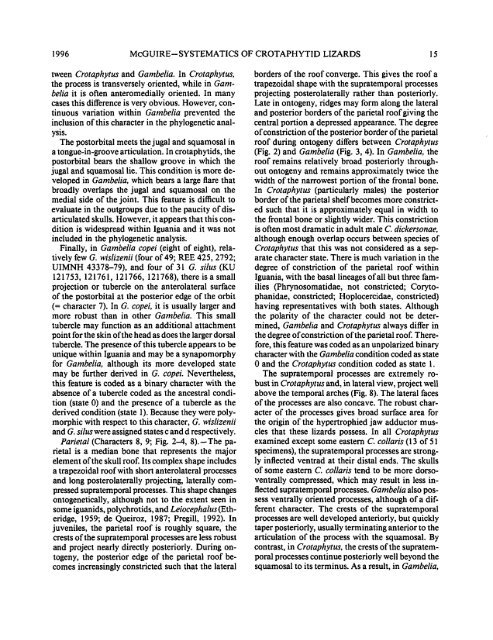Download Full Document - Mountain Boomer Music!
Download Full Document - Mountain Boomer Music!
Download Full Document - Mountain Boomer Music!
Create successful ePaper yourself
Turn your PDF publications into a flip-book with our unique Google optimized e-Paper software.
McGUIRE-SYSTEMATICS OF CROTAPHYTID LIZARDS<br />
tween Crotaphytus and Gambelia. In Crotaphytus,<br />
the process is transversely oriented, while in Gam-<br />
belia it is often anteromedially oriented. In many<br />
cases this difference is very obvious. However, con-<br />
tinuous variation within Gambelia prevented the<br />
inclusion of this character in the phylogenetic anal-<br />
ysis.<br />
The postorbital meets the jugal and squamosal in<br />
a tongue-in-groove articulation. In crotaphytids, the<br />
postorbital bears the shallow groove in which the<br />
jugal and squamosal lie. This condition is more de-<br />
veloped in Gambelia, which bears a large flare that<br />
broadly overlaps the jugal and squamosal on the<br />
medial side of the joint. This feature is difficult to<br />
evaluate in the outgroups due to the paucity of dis-<br />
articulated skulls. However, it appears that this con-<br />
dition is widespread within Iguania and it was not<br />
included in the phylogenetic analysis.<br />
Finally, in Gambelia copei (eight of eight), rela-<br />
tively few G. wislizenii (four of 49; REE 425, 2792;<br />
UIMNH 43378-79), and four of 3 1 G. silus (KU<br />
121753, 121761, 121766, 121768), there is a small<br />
projection or tubercle on the anterolateral surface<br />
of the postorbital at the posterior edge of the orbit<br />
(= character 7). In G. copei, it is usually larger and<br />
more robust than in other Gambelia. This small<br />
tubercle may function as an additional attachment<br />
point for the skin ofthe head as does the larger dorsal<br />
tubercle. The presence of this tubercle appears to be<br />
unique within Iguania and may be a synapomorphy<br />
for Gambelia, although its more developed state<br />
may be further derived in G. copei. Nevertheless,<br />
this feature is coded as a binary character with the<br />
absence of a tubercle coded as the ancestral condi-<br />
tion (state 0) and the presence of a tubercle as the<br />
derived condition (state 1). Because they were poly-<br />
morphic with respect to this character, G. wislizenii<br />
and G. silus were assigned states c and d respectively.<br />
Parietal (Characters 8, 9; Fig. 24, 8).-The pa-<br />
rietal is a median bone that represents the major<br />
element of the skull roof. Its complex shape includes<br />
a trapezoidal roof with short anterolateral processes<br />
and long posterolaterally projecting, laterally com-<br />
pressed supratemporal processes. This shape changes<br />
ontogenetically, although not to the extent seen in<br />
some iguanids, polychrotids, and Leiocephalus (Eth-<br />
eridge, 1959; de Queiroz, 1987; Pregill, 1992). In<br />
juveniles, the parietal roof is roughly square, the<br />
crests of the supratemporal processes are less robust<br />
and project nearly directly posteriorly. During on-<br />
togeny, the posterior edge of the parietal roof be-<br />
comes increasingly constricted such that the lateral<br />
borders of the roof converge. This gives the roof a<br />
trapezoidal shape with the supratemporal processes<br />
projecting posterolaterally rather than posteriorly.<br />
Late in ontogeny, ridges may form along the lateral<br />
and posterior borders of the parietal roof giving the<br />
central portion a depressed appearance. The degree<br />
of constriction of the posterior border of the parietal<br />
roof during ontogeny differs between Crotaphytus<br />
(Fig. 2) and Gambelia (Fig. 3, 4). In Gambelia, the<br />
roof remains relatively broad posteriorly through-<br />
out ontogeny and remains approximately twice the<br />
width of the narrowest portion of the frontal bone.<br />
In Crotaphytus (particularly males) the posterior<br />
border of the parietal shelf becomes more constrict-<br />
ed such that it is approximately equal in width to<br />
the frontal bone or slightly wider. This constriction<br />
is often most dramatic in adult male C. dickersonae,<br />
although enough overlap occurs between species of<br />
Crotaphytus that this was not considered as a sep-<br />
arate character state. There is much variation in the<br />
degree of constriction of the parietal roof within<br />
Iguania, with the basal lineages of all but three fam-<br />
ilies (Phrynosomatidae, not constricted; Coryto-<br />
phanidae, constricted; Hoplocercidae, constricted)<br />
having representatives with both states. Although<br />
the polarity of the character could not be deter-<br />
mined, Gambelia and Crotaphytus always differ in<br />
the degree of constriction of the parietal roof. There-<br />
fore, this feature was coded as an unpolarized binary<br />
character with the Gambelia condition coded as state<br />
0 and the Crotaphytus condition coded as state 1.<br />
The supratemporal processes are extremely ro-<br />
bust in Crotaphytus and, in lateral view, project well<br />
above the temporal arches (Fig. 8). The lateral faces<br />
of the processes are also concave. The robust char-<br />
acter of the processes gives broad surface area for<br />
the origin of the hypertrophied jaw adductor mus-<br />
cles that these lizards possess. In all Crotaphytus<br />
examined except some eastern C. collaris (1 3 of 5 1<br />
specimens), the supratemporal processes are strong-<br />
ly inflected ventrad at their distal ends. The skulls<br />
of some eastern C. collaris tend to be more dorso-<br />
ventrally compressed, which may result in less in-<br />
flected supratemporal processes. Gambelia also pos-<br />
sess ventrally oriented processes, although of a dif-<br />
ferent character. The crests of the supratemporal<br />
processes are well developed anteriorly, but quickly<br />
taper posteriorly, usually terminating anterior to the<br />
articulation of the process with the squamosal. By<br />
contrast, in Crotaphytus, the crests of the supratem-<br />
poral processes continue posteriorly well beyond the<br />
squamosal to its terminus. As a result, in Gambelia,


